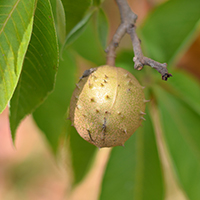What Ohio buckeye looks like
Size and shape
- Small tree that reaches 15 metres high.
- Occasionally grows mores shrub-like.
Leaves
- Bright green compound leaves with 5 to 7 leaflets.
Bark
- Scaly grey bark.
Flowers
- Upright clusters of yellow-green flowers bloom in spring.
Fruit
- Large brown fruits with a thick, prickly husk.
- Contain 1 to 3 large, smooth brown seeds with a distinct light-coloured scar.
Where Ohio buckeye is found
In Ontario, Ohio buckeye has only been found growing naturally in one area in Southwestern Ontario near Lake St. Clair. Ohio buckeye is occasionally planted as an ornamental tree elsewhere in Southern Ontario and is common in the Midwestern United States.
What you need to know to grow Ohio buckeye
- Moisture: grows best in evenly moist soils.
- Soil: adaptable to most soils, does not tolerate clay, tolerates slightly acidic soils.
- Shade: tolerates full shade but grows best in partial shade.
- Cautions:
- drought: Ohio buckeye can drop its leaves early if planted on light sandy or loamy soils or because of summer droughts
- water well in the first two seasons after planting and mulch heavily to maintain good health
- location: since Ohio buckeye does not grow naturally throughout most of Ontario, use seeds from other established landscape trees in your area or talk to an arborist for planting stock options
Benefits and uses of Ohio buckeye
Wildlife benefits
Ohio buckeye is not a popular food source for wildlife due to its toxic and unpalatable leaves and twigs. Ohio buckeye flowers attract pollinators such as hummingbirds, bees and butterflies.
Commercial uses
Ohio buckeye wood is soft and unpopular for most woodworking, although it is sometimes used for furniture and small specialty items. Ohio buckeye is occasionally planted as an ornamental landscape tree due to its dense crown and attractive fall colours.
Fun facts about Ohio buckeye
- Ohio buckeye is named for its seeds’ resemblance to a buck’s eye.
- Ohio buckeye is the state tree of Ohio.
- Although Ohio buckeye seeds are poisonous to livestock, squirrels are known to eat the insides, which contains a sugar sweeter than sucrose.
Updated: January 10, 2024
Published: July 18, 2014




